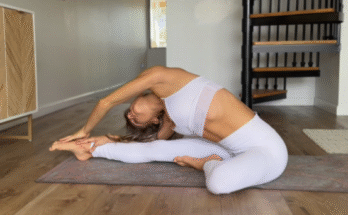
The beauty of yoga, gymnastics, and calisthenics lies in their endless possibilities for creativity and expression. One of the most breathtaking moves that combines strength, flexibility, and grace is the handstand into a split. This movement isn’t just about showing off an impressive skill—it’s about exploring the balance between stability and freedom, discipline and artistry.
For many practitioners, being able to transition from a strong handstand into an elegant split is a milestone. It represents not only advanced body control but also the confidence to take risks and expand the boundaries of what the body can achieve. In this article, we’ll dive deep into what it means to master this movement, why it’s beneficial, how to practice safely, and how to enjoy the process along the way.
The Allure of the Handstand Split
When you see someone balance on their hands and gracefully open their legs into a split, it’s hard not to be inspired. There’s a sense of weightlessness, almost like flying upside down. What makes it so fascinating is that it combines two demanding skills: the handstand, which requires balance, strength, and focus, and the split, which requires flexibility, hip openness, and body awareness.
For dancers and gymnasts, this move adds artistry and variety to routines. For yoga practitioners, it’s a powerful expression of control and expansion. For fitness enthusiasts, it’s simply a fun challenge that brings together multiple aspects of training in one move.

Benefits of Practicing a Handstand into a Split
Mastering this movement isn’t only about aesthetics—it comes with numerous benefits for your body and mind:
- Improved Balance – Balancing on your hands forces you to fine-tune the small stabilizing muscles in your shoulders, wrists, and core. Adding a split challenges balance even further by shifting your center of gravity.
- Core Strength – A strong core is essential for holding the body upright in a handstand. Extending into a split engages deeper layers of abdominal muscles and lower back stabilizers.
- Hip Flexibility – To achieve a split, the hamstrings, hip flexors, and glutes must be flexible. Practicing this move encourages a healthy balance of strength and openness in the hips.
- Body Awareness – When upside down, your sense of orientation shifts. Moving into a split develops proprioception—knowing where your body is in space.
- Mental Focus – Handstands demand concentration. Adding a split challenges your ability to remain calm, focused, and controlled even when the movement gets more complex.
- Confidence and Creativity – Achieving this skill boosts self-confidence and unlocks creativity in movement, giving you more freedom to explore transitions, flows, and expressive shapes.

Step-by-Step Guide to Handstand into a Split
Once you’ve built the foundation, you can start practicing the transition itself. Here’s a breakdown of how to approach it:
- Find Your Handstand
Kick up into a handstand with control. Start against a wall if needed. Focus on stacking your shoulders over your wrists and engaging your core. - Engage Your Core and Hips
Before moving into a split, lock your foundation. Press firmly into the ground with your hands, keep your shoulders strong, and draw your ribs inward. - Start with a Small Split
Instead of dropping into a full split right away, begin by slightly opening your legs apart. This helps you understand how your balance shifts. - Gradually Extend
Slowly push one leg forward and the other backward, moving toward a deeper split. Keep your movements controlled and intentional. - Breathe and Hold
Once in the split, breathe steadily. Avoid holding your breath, as it creates tension and instability. - Exiting Safely
To come out, either bring your legs back together into a straight handstand or gently cartwheel down to one side. Practice safe exits so you don’t fear falling.
Tips for Success
- Train Consistently but Patiently – This move won’t come overnight. Small, consistent efforts build strength and flexibility over time.
- Use the Wall – Practice handstands facing the wall so you can slide one leg into a split while staying supported.
- Film Yourself – Recording your practice gives valuable feedback on alignment and balance.
- Focus on Control, Not Speed – Rushing into a split can throw you off balance. Slow, controlled movements are safer and more effective.
- Listen to Your Body – Never force a split if your hamstrings or hips feel painful. Progress gradually to avoid injury.

Common Mistakes to Avoid
- Arching the Back Too Much
Many people compensate for lack of hip flexibility by over-arching the lower back. This can strain the spine. Keep the core engaged and lengthen through the legs instead. - Collapsing Shoulders
If your shoulders sink, the entire structure becomes unstable. Keep pushing the ground away and maintain active shoulders. - Forgetting to Breathe
Holding your breath creates tension. Stay relaxed and let your breath guide the movement. - Rushing the Progression
Skipping the basics often leads to frustration or injury. Build strength and flexibility step by step.
The Mental Journey
Beyond the physical practice, the handstand into a split teaches important life lessons. It shows that progress is not linear—you’ll have days when balance feels impossible and others when everything clicks. It encourages patience, discipline, and resilience.
It also inspires playfulness. Inversions remind us not to take ourselves too seriously. Falling out of a handstand isn’t failure—it’s part of the learning process. Every attempt is a step closer to mastery.

Bringing It into Your Practice
Whether you’re a yogi, dancer, gymnast, or fitness enthusiast, this move can enrich your practice. You can incorporate it into yoga flows, gymnastics routines, or even just as a personal challenge. Over time, you may find creative variations: straddle splits, scissor kicks, or transitions into backbends.
What matters most is the journey. Each practice session builds strength, flexibility, and confidence. The split in a handstand is just the visible expression—the true reward is in the growth and self-discovery along the way.
Conclusion
The handstand into a split is more than a flashy move. It’s a celebration of balance, strength, flexibility, and artistry. It pushes you to connect deeply with your body, to embrace challenges, and to move beyond comfort zones.
With patience, dedication, and a playful spirit, anyone can work toward this goal. So next time you roll out your mat or step onto the gym floor, remember: it’s not just about holding the perfect handstand or the deepest split. It’s about the journey of learning, exploring, and finding joy in movement.
And one day, when you kick up, engage your core, and gracefully open into a split—you’ll feel that magical moment where effort meets freedom.



